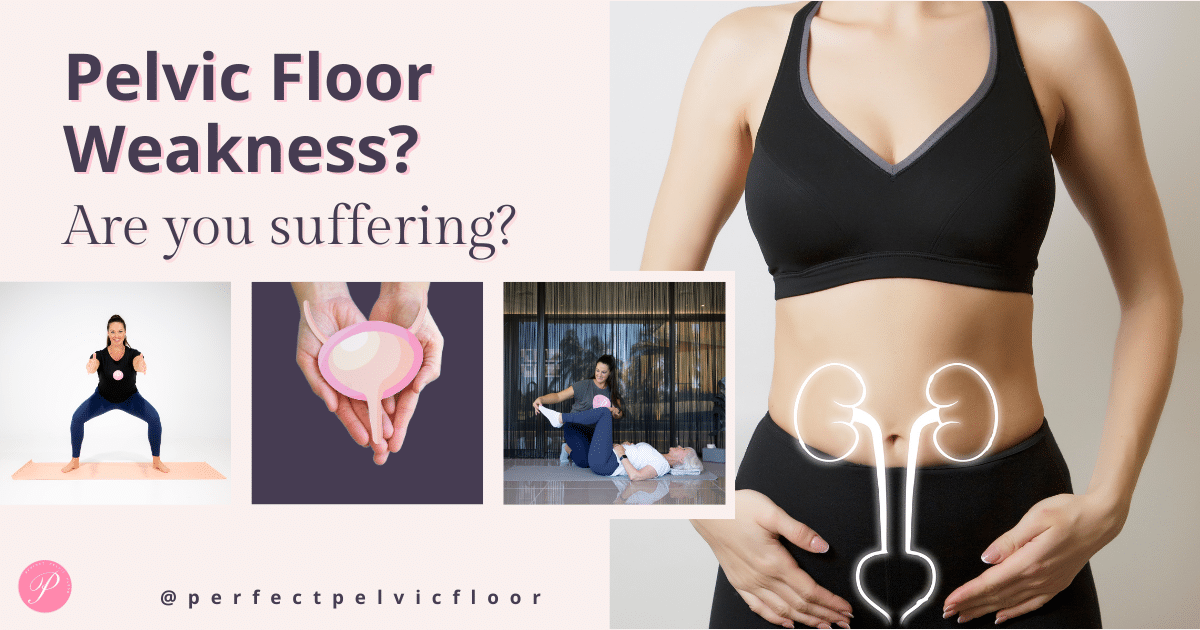Pelvic Floor Weakness
What does pelvic floor weakness mean? What role does your bladder have with your pelvic floor muscles?
What are the signs of pelvic floor weakness?
Such great questions and very common ones. It’s still amazes me how little women know about their body so let’s start with your bladder….
Your bladder if under the age of 70 should store 350ml to 500ml of urine and will send a stretch message to your brain when your bladder is full.
The bladder is a muscular pump sitting behind your pubic bone and shaped a little like a water balloon. Your kidneys feed urine into your bladder and your bladder empties out via a tube called your urethra. Your urethra has a sphincter on the end of it which is a little like a clamp. The bladder muscles itself is called the detrusor muscle.
Once your brain gets the message that your bladder is full, your pelvic floor muscles and your urethral sphincter (clamp) relax, then it’s your bladder’s job as a muscle (detrusor) to pump out the urine by contracting.
Your pelvic floor then contracts and the outlet is closed (meaning no urine escapes out), allowing your bladder to relax and refill as you go about your day.
So basically your pelvic floor muscles play a very important role in your bladder mechanics.
Pelvic Floor Weakness
So what happens with pelvic floor weakness or if your pelvic floor muscles have lost some of their strength?
Your pelvic floor might not be able to contract enough to close of the urethra. Or your bladder starts getting the response that it needs to empty when it isn’t completely full. This can occur when we have “just in case” wee’s too often. This can also happen when we don’t drink enough water. When we’re dehydrated or have too much caffeine or alcohol the acidity levels in our urine become higher causing our bladder to expel urine more frequently.
Then there is the weakness associated with too much extra pressure downwards within our trunk call intra-abdominal pressure and our pelvic floor muscles can’t cope. Particularly with movements that are high intensity like jumping, coughing and sneezing etc.
Common signs your pelvic floor muscles aren’t working effectively:
Leakage
Don’t make it to the bathroom in time
Leakage with coughing, jumping, laughing, sneezing
Back pain
Frequently needing to urinate – then not much comes out
Going to the toilet more than once/night
Avoiding sexual intimacy
Avoiding exercise for fear of leakage
Essentially you want to have a strong pelvic floor to be able to contract your muscles but also know how to relax them to allow the normal bodily functions to occur. This is what I call pelvic floor control, which is what we’re all aiming for and is the goal of all our PPF programs.To allow you to build your awareness and strength in both turning on and turning off your pelvic floor muscles. Read more on the pelvic floor muscles
Effective Bladder strategies to improve your pelvic health:
Never strain to empty your bladder or push on your stomach, just relax your pelvic floor and your abdominals allowing your urine to flow out easily.
Sit on the toilet, with your feet just under you, on your toes allowing your body to learn forward slightly. This position helps with both bladder and bowel movements adjusting to the position of gravity.
Drink enough water to stay hydrated, .033 X your body weight for a rough estimate in litres/day and more if you are exercising or breastfeeding.
Caffeine can be an irritant to your bladder – minimise the amount you have per day (that includes caffeinated tea)
Alcohol is a diuretic, a bladder irritant and a muscle relaxant which will make frequency or urgency issues worse. Reduce or avoid if possible.
Stop doing the “just in case visits” to the bathroom, only go when you get the sensation your bladder is full.
Only encourage your daughters to urinate when they need to.
Starting to think your pelvic floor muscles need some help? Take our free Vagina Winks Test to see if they are for you.
Allowing you to prevent embarrassing leakage, connect to your pelvic floor & say hello to intense orgasms.
References
Womens Waterworks by Dr Pauline Chiarelli
Pelvic Floor Essentials by Sue Croft












